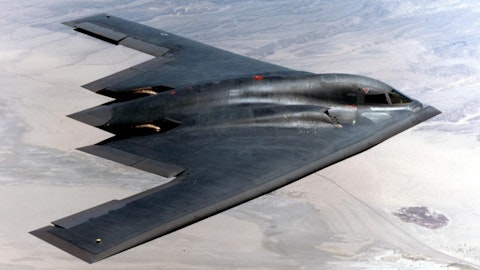John Plant: So if I give you, let’s say, the fourth quarter, we believe we delivered at rate 38, while Boeing build, let’s say, rate 30. So, in Q4, let’s assume that 8 aircraft sets per month went into inventory. So, there’s 24 sets of parts which are sitting in Boeing inventory for the structural part, that our estimation. I don’t think it’s just quite the same on the engine side. Because what wasn’t built in engines, let’s say, the reduced engine build, which you’ve already had commentary from the engine manufacturers about that then the balance of the majority of the part, certainly on the turbine side, but not necessarily on the structural side, essentially went into service parts delivery into the MRO shops to account for what I already just talked about.
Noah Poponak: Okay.
John Plant: And so if you think about it, assuming that Boeing taking Q1 at 38, depending on what the final thing is, then there is — if they build up, my assumption is 34, maybe they’ll bill at 38. That’s why I’ve allowed for some choppiness as I already commented on, and allowed for some inventory that we may end up carrying as that gets ironed out and with how many people will recruit or we have already commented on that. And so, it’s allowed for that, and it’s allowed for some of that choppiness within the margin rate incrementals that I’ve given, calling out 28 versus 31 in Q4.
Noah Poponak: Okay. Super helpful. Thanks so much.
John Plant: Thank you.
Operator: The next question comes from Robert Spingarn with Melius Research. Please go ahead.
Scott Mikus: Hi. Scott Mikus on for Rob Spingarn. John, I wanted to ask you, the last time you had mentioned this, it was — I believe you had 1.5 times the relative market share of your closest competitor in the airfoils market. So just with the upgrade to the GTF and then also thinking about the new engine agreement with an engine OEM customer that you referenced, where does your relative market share stand now in the airfoils market?
John Plant: Okay. We have grown about 1% share a year in the turbine airfoils market over the last, let’s say, four or five years. And so, it’s been a consistent march, and we believe we’re just around that 50% mark currently. And we see that continuing to grow commensurate with some of the, I’ll say, extraordinary levels of technology that we bring in that segment. And also I’ve commented here, we would not be considering, let’s say, investing further in the scale that I’ve referred to, without knowledge of that share being there and indeed, I did say very clearly and unequivocally that we’ve also contracted additional share within that. So, we continue to drive that improve it. And as you did here, hopefully, is that’s not changing our free cash flow guide metric, the conversion of net income.
Scott Mikus: Okay. And then as a follow-up, I wanted to ask, did you see any pickup in spot sales in 2023? And do you have any assumption for spot sales baked into the 2024 guide?
John Plant: Yeah. We did see the spot market pick up further in ’23. You can never be sure. So, we’ve just assumed it’s played again in 2024. And we did put in some security stock of material such that we could respond to the spot market and our balance sheet could take it. But we not assume that it’s like a further significant step-up because it’s also in that unknown area of indeed what hadn’t been previously scheduled, what additional demands are there and sometimes the opportunity for an increased share if somebody else is not able to deliver. So, it’s not an easy number to say. We assume that we’re going to get more. I don’t think that’s a sensible way to plan.
Scott Mikus: Thanks for taking the questions.
John Plant: Thank you.
Operator: The next question comes from Seth Seifman with JPMorgan. Please go ahead.
Seth Seifman: Hey, thanks very much and good morning.
John Plant: Hi, Seth.
Seth Seifman: Good morning. If I could ask maybe a two-part question, just about all this 737 and just understanding that dynamic. You spoke, I guess, extensively about Boeing and the production rate there. Can you talk about at the — on the engine side, and kind of where that level of production is expected to be in 2024? And then on the airframe side, how much — I assume most of the 737 content on the airframe side is in fasteners? And I guess, so how much of that goes directly to Boeing versus how much would be going to other suppliers like maybe Spirit especially. And so that would imply that your expectation in terms of the demand pull for Howmet would be more — not even necessarily a demand pull from Boeing directly, but the demand pull from the, let’s say, Tier 1 in the Boeing supply chain.
John Plant: Yeah. So, we do supply, I going to say, in terms of commercial — for Boeing’s requirements, we supply the majority directly to Boeing. But we also do supply Spirit as an example and others that are also providing subassemblies to Boeing. And so again, it’s never an absolutely clear picture. But we just assume like we’ve taken an assumption of a number of aircraft sets. It could be that Boeing build at one level. And maybe another supplier might build at a different level, and it’s also compared to what they want to hold and also indeed what Boeing have by way of their minimum, maximum inventory holdings as well. So, we operate on a min-max system, just roughly correlated to build, but as times when it breaks that correlation.
So, it’s never quite straightforward, Seth, I don’t want to burden you is, I’ll say, unnecessary detail, but the best assumption is just we’ve based that on 34 and all of the other suppliers of rate 34 and knowing that at some point, that if Boeing have been scheduling at a higher rate and build the inventory has to come out and so there be held because there’s going to be — maybe the rate assumption will go up, maybe it will be 42, maybe be 47 in 2025. And therefore, because it’s really important that all the parts are there, so you avoid traveled work, which has been set a lot of commentary recently. So having supply security and all the parts available is really important. And therefore, it could well be that all of that will be held, which we don’t know that.





